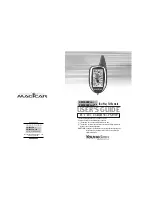
Curtis PMC 1204X/1205X/1209/1221 Manual
17
WIRING
Fig. 13
Bi-directional
twist-grip throttle with a
standard 20 k
Ω
pot and a
controller with the
optional 5k
Ω
–0 throttle
input.
TO
THROTTLE
INPUT
20 k
Ω
SPEED
INCREASES
BOTH WAYS
Fig. 14
Reduced speed
operation (with standard
0–5k
Ω
pot).
TO
THROTTLE
INPUT
SPEED
REDUCTION
RESISTOR
FASTER
OPTIONAL
SWITCH
SPEED REDUCTION RESIST
OR
(k ohms)
APPROX. % OF ORIGINAL TOP SPEED
0
20
40
60
80
100
25
20
15
10
5
0
0
–
5k
Ω
A third method of accommodating bi-directional twist grip throttles uses a
standard potentiometer and a controller with a nonstandard throttle input. As
shown in Figure 13, a standard 20 k
Ω
pot is used, with its end terminals wired
together. The resistance goes from
5 k
Ω
at neutral to zero at the
extremes—the opposite of the
standard throttle input configu-
ration. Contact the factory if you
need this type of controller.
WARNING: with the input circuit shown in Figure 13,
potentiometer or wiring open circuits turn off the controller’s
output. However, pot wiring shorts appear the same as a
normal zero ohm signal to the controller, and will produce
full speed operation if the short occurs while the power is on.
Reduced Speed Operation
Vehicle top speed can be easily limited, for safety or other reasons. A single resistor
connected in parallel with the throttle pot will reduce maximum speed according
to its resistance value, as shown in Figure 14. Use of a variable resistor makes
adjustment of maximum speed easier. With a switch, speed can be limited in
reverse only, or the speed reduction can be switched off—for example, to allow
authorized personnel to run the vehicle outdoors at full speed.
The speed reduction shown in the curve is approximate. The actual vehicle
top speed will depend on the motor characteristics and the vehicle load. You
















































